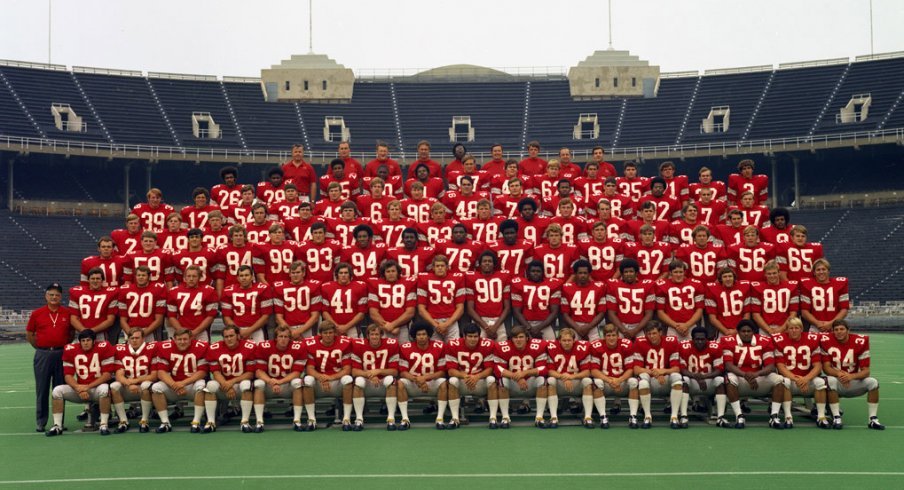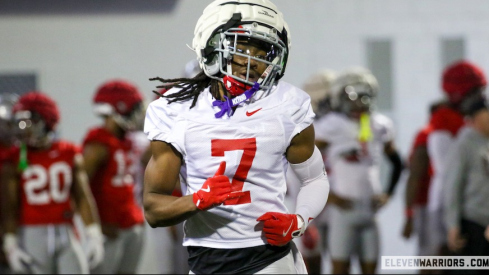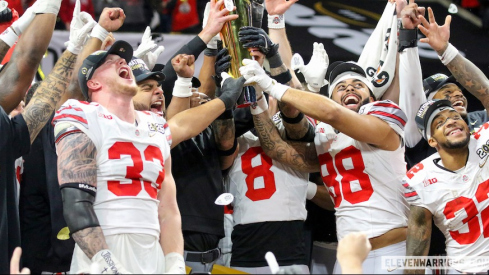The 1971 season marked the end of an historic era of Ohio State football as Woody Hayes' 1967 recruiting class, dubbed the Super Sophs on the way to the 1968 national title, all moved on.
The Super Sophs read like a who's who of Buckeye legends to play for Woody with names like Jack Tatum, Jim Stillwagon, Mike Sensibaugh, Rex Kern, Jan White, John Brockington, Tim Anderson and Leo Hayden, among others, accounting for 17 departed starters as Hayes entered the 1971 campaign, his 21st at the helm in Columbus.
The Super Sophs went 29-2 from 1968-70, capturing a national title and three-straight Big Ten crowns, leaving Woody woefully short-handed in what would be the last season freshmen were ineligible to compete on the varsity squad.
Coming off a 9-1 record and an appearance in the 1970 Rose Bowl, Hayes' '71 squad knew it couldn't go to a bowl game no matter how it fared thanks to the Big Ten's "no repeat rule" keeping the Big Ten champion from going to the Rose Bowl in consecutive seasons (along with the league only partnering with one bowl).
Speaking of bad news, the 1971 season also marked the debut of AstroTurf in the Horseshoe after 49 years of natural grass. The bright side of the carpet came as it was funded by Lou Fischer, a guard at Ohio State in the early 50s, in tribute to his friend, teammate and business partner, Joe Campanella, who passed suddenly in 1968.
On the turf, job one was replacing Kern and Ron Maciejowski at quarterback, a job that mostly fell on the shoulders of Don Lamka. Other notable names counted on the fill big shoes included John Hicks, Glen Mason, Fred Pagac, Stan White and Randy Gradishar, among others.
The season started on a great note as the Buckeyes thumped Iowa, 56-21, behind four touchdowns from Lamka and a pair of scores from fullback John Bledsoe. The win vaulted Ohio State to No. 6 in the AP Poll.
After an open week, the Buckeyes welcomed No. 10 Colorado to the Shoe. The afternoon proved notable as TBDBITL performed its first ever script Woody before his team recorded its first home loss since October 28, 1967, ending a 19-game home winning streak.
Ohio State trailed the Buffs 13-0 in the fourth quarter and cut the margin to 20-14 in the final minutes on the strength of 255 passing yards from Lamka but a failed onside kick ruined any chance at a miracle comeback. The Buckeyes actually recovered the onside kick but the referees ruled the ball didn't travel 10 yards, to which Woody... ahem, vehemently disagreed.
The 1-1 start in September wasn't what Woody was looking for despite the strong effort against the Buffaloes but his Buckeyes would roll through October, posting five straight victories.
The first came as Woody's squad throttled Cal, 35-3, even after Lamka hurt his shoulder. Hayes leaned on his running game to the tune of 317 yards including a 40-yard touchdown jaunt from backup quarterback Greg Hare.
A trip to Champaign followed and Ohio State responded with a 24-10 victory despite playing without starters Bledsoe and Pagac. Injuries continued to be the story as defensive tackle Shad Williams was lost for the season while two others in the trenches also went down. The most impactful came as Hicks, Woody's stud offensive tackle, suffered a season-ending knee injury.
With Lamka back the following weekend to face Indiana, Ohio State prevailed 27-7 behind he and Hare's combined 263 passing yards - 204 of which came from the arm of Hare. With the Buckeyes averaging just 2.5 yards per carry, they led 13-7 entering the fourth quarter before putting the game away with two late touchdowns.
According to Ohio State football historian Jack Park, the Buckeyes deployed the wishbone-T formation for the first time during the '71 season in a 31-6 bashing of the Wisconsin Badgers. Tailback Morris Bradshaw was the offensive star with an 88-yard rushing touchdown and an 88-yard kickoff return for another score. On defense, Gradishar got loose for 18 tackles and two fumble recoveries.
Capping the month at Minnesota, the Buckeyes held on for a 14-12 decision, stopping a Gophers 2-point conversion try in the game's final minute. The win moved Woody's squad to 6-1 overall and No. 9 in the polls.
But then the wheels fell off.
Woody's shaky offense let the Buckeyes down in a 17-10 loss to Michigan State, committing four turnovers while completing two passes as the running game averaged less than 3.5 yards per try. The defense did its job once more, holding Sparty to under 200 total yards as Gradishar posted 15 tackles.
The following weekend produced another home loss, this time to Northwestern, 14-10. Again the offense stunk it up, churning out 210 total yards on 2.8 yards per rush and 4-of-8 passing with an interception. Defensive stalwarts Gradishar (18 tackles) and Vic Koegel (21 stops) once again did their part.
Now standing a pedestrian 6-3, the Buckeyes headed to Ann Arbor to face a Michigan squad sporting a 10-0 record and a No. 3 ranking. Injuries and a predictable scheme again failed the offense as it cranked out 138 total yards, this time on 1.9 yards per rush.
The Buckeyes still led 7-3 deep into the fourth quarter thanks to an 85-yard punt return touchdown from Tom Campana and another stout defensive performance but the Wolverines would drive 72 yards with about two minutes remaining to take a 10-7 lead.
Woody's offense had its last gasp stopped by a Lamka interception at the Michigan 32. Grainy footage indicates pass interference could've been called, it wasn't, prompting a Hayes meltdown for the ages. Woody ran onto the field, berated the official(s) and eventually shredded a downs marker as Ohio State's chance at an upset vanished.
The game marked the first time in Woody's 21 years at Ohio State that he didn't meet with the media postgame.
The loss ended Ohio State's season with a 6-4 record thanks to an offense that averaged 3.9 yards per carry and tossed two touchdown passes all season, completing 47.6% of its 168 attempts. The three-game skid against conference foes was the first such streak since Woody's arrival in 1951.
Richard Galbos led the team with 540 rushing yards (3.8 ypc) and Dick Wakefield paced the receiving corps with 432 yards. On defense, Koegel tallied 126 stops, White 100 and Gradishar 84. Center Tom DeLeone earned All-American accolades.
While the 1971 season showcased a program in transition, the 1972 squad marked a return to excellence, sparked largely by the arrival of a freshman by the name of Archie Griffin.


